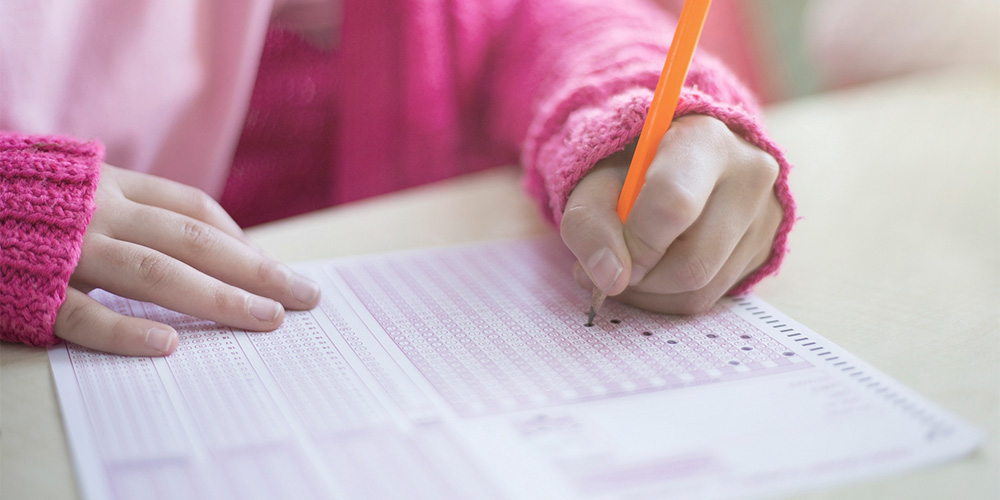In our decades of providing teachers with classroom tools and resources, we’ve spoken with thousands upon thousands of educators about their needs, ideas, and concerns. During that time, not a single member of the community has expressed any admiration for state tests. Ergo, it seems stress is an unfortunate and inherent element of standardized assessments.
That’s true for the students who feel that their scores speak to their academic progress and self-worth. And it’s also accurate for the teachers who want to provide an individualized and transformational education for their students, but have to pay at least some credence to an outdated and draconian model of measuring progress. That said, let’s take a gander at how to manage state test stress levels.
Why Does State Test Stress Exist?
For the most part, state test results function as a springboard for funding and accolades. Designed with upper-class, suburban children in mind, these exams have become a source of concern for the teachers who actually know their students and know what would constitute quality assessment for their progress in the classroom.
So, in a nutshell, this is why state test stress exists. The assessments don’t cater to children’s individual strengths, nor do they provide a full depiction of what needs to improve. Nevertheless, the results serve as the measuring rod for support and funding decisions.
But what can be done?
State Test Stress on Students
Harvard researchers conducted a study on the effects of stress on state test performance. In a nutshell, the stress students feel about these high-stakes assessments disproportionately impacts kids from impoverished neighborhoods. “High-stakes” is a key descriptor, as the lackluster results generally indicate a school receives fewer resources. In the real world, this means less technology, out-of-date textbooks, etc.
By virtue of their zip code, this pattern traps working-class kids in a cycle of poverty and struggle. Even young children must be aware of this inequity on some level. But regardless of their students’ socioeconomic stations, teachers and administrators can help mitigate state test anxiety with the following methods.
Teaching study techniques
Teachers know this, but it bears repeating: Studying is a skill that can be taught and learned, specifically when it comes to preparing for high-stakes tests. Long bouts of memorization won’t do much on standardized assessments (or in low-stakes testing, for that matter). Instead, teachers can provide their students with pre-tests, self-quizzing, and paraphrasing activities.
Hosting open classroom forums
Honesty is paramount. While teachers often find themselves muzzled on certain topics, the subject of state tests is not a classroom taboo. When talking to your students, it’s important not only to explain state tests, but to encourage questions about them. Of course, candor does not mean creating more anxiety by telling students about the funding implications of their performance. On the contrary, honesty about how these tests are important, but not a measure of a student’s worth, will decrease pressure.
Staying aware of learning differences
Education writers and advocates for those with less privilege often point to the racial, geographical, and socioeconomic biases of state tests. And while there’s no denying that harsh reality, we’d be remiss not to mention the test designs also fail to account for learning differences. Parents and teachers know these children best, and in this regard, it’s paramount to communicate and reach out for all available services to help students maximize their strengths and mitigate disadvantages.
Leveraging relaxation techniques
There’s nothing frivolous or insincere about conscious breathing — the old deep-breath-in-and-out routine quite effectively focuses your brain and lowers cortisol levels. To that end, there’s nothing so therapeutic as having a laugh, so when laughter breaks out at an appropriate time, we recommend seeing it as a healing experience instead of an outburst. No matter where the relief originates from, part of state test stress manifests in physical anxiety, and if your class can learn to control these responses, the situation will feel far less threatening.
Mitigating the stakes
While teachers have no say in the power of these state assessments, they are the ones who communicate with their students about them. Educators should reassure students that, while the tests are not unimportant, they do not measure every form of intelligence and aptitude. They are designed by people who do not know them or all their capabilities, strengths, challenges, and needs.
Even if you don’t find state tests useful, they’ve been a staple in public K–12 education for a long time. And unfortunately, there’s not much talk about how to change the way we assess performance. If you want to improve scores and mitigate stress, we recommend training that will help soften kids’ anxiety, understand why inequities exist, assist students with learning differences, and support the people in your classroom who don’t enjoy the privileges others have.







